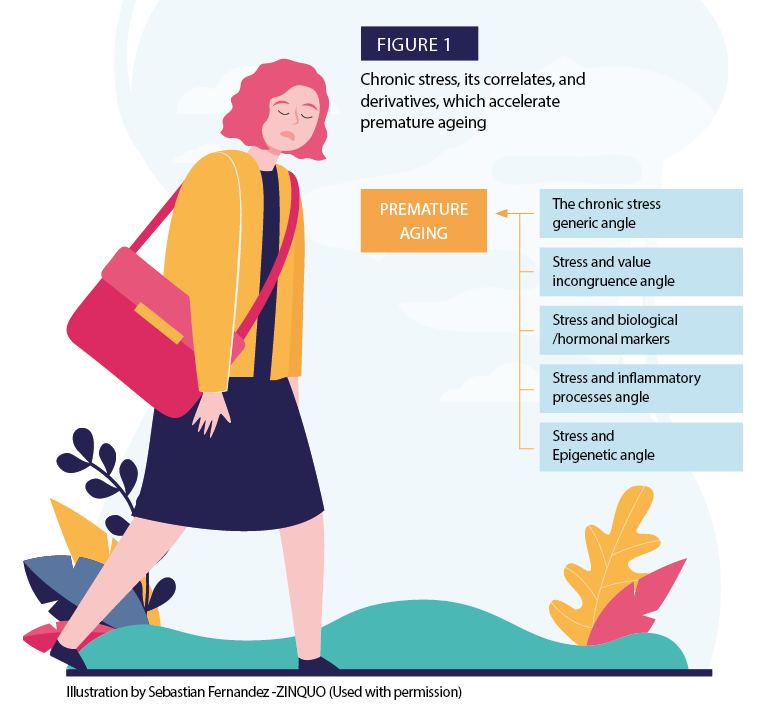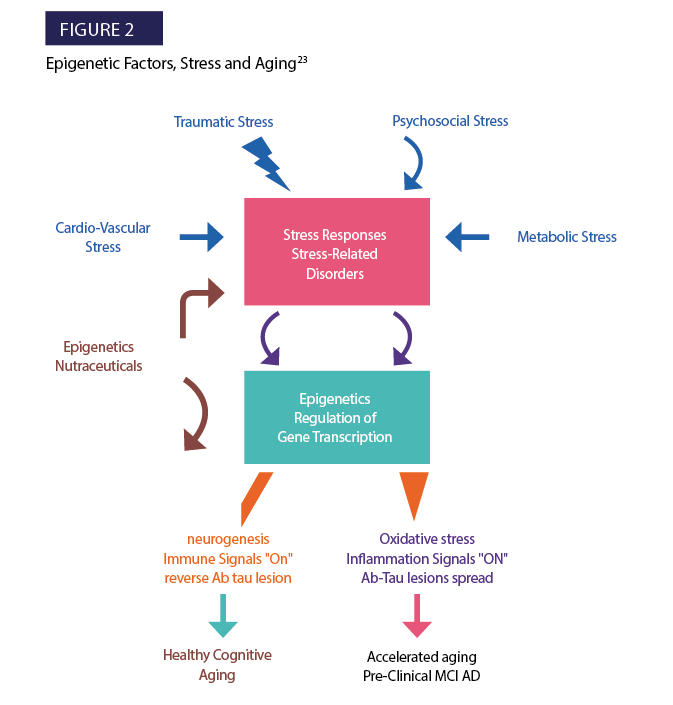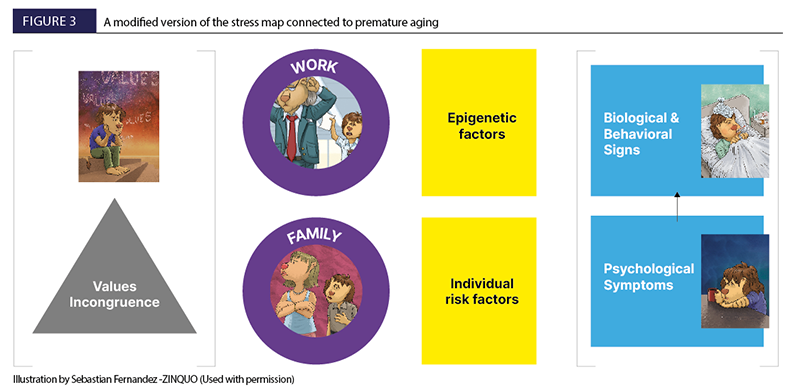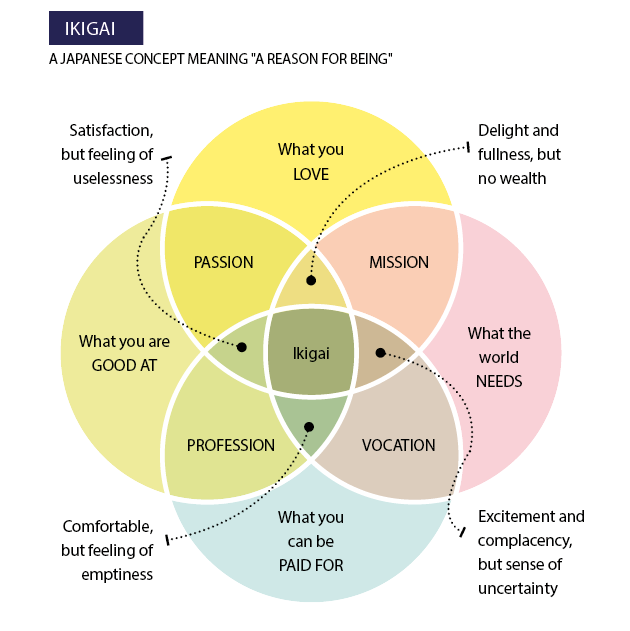By Prof. Simon L. Dolan and Prof. Mario Raich
Introduction
The idea of stress and aging was born many years ago while one of the co-authors of this paper, Simon L. Dolan, was a junior researcher working with the famous team of Dr. Hans Selye at the University of Montreal. Hans Selye is considered by many to be the “father of stress”, or the founder of the concept of stress in modern medicine. i Dolan joined the team in 1978 and stayed and worked with Hans Selye until his unexpected death in 1982. In 1980, Selye wrote the preface to Dolan and Arsenault first book on stress in Frenchii. The team had several periodic meetings where new discoveries by members of the team were shared, and substantial time was also devoted to new ideas for setting a future research agenda. This was the first time that we heard Hans Selye and his close friend Dr. Paul Rohan propose a redefinition of stress as a concept of accelerated aging (or premature aging). But we did not really set up a program to study it. Now, as we are preparing to publish the latest editions of books on chronic stressiii, we thought it is an opportunity to tackle again this challenging proposition and perhaps shed more light on the multiple relationships between stress and aging. We hope readers will understand this phenomenon better and perhaps can be involved in adopting measures and respective lifestyles to slow down the process of premature aging. In addition, an attempt is made to simplify concepts without trading off the scientific rigor.
Simply stated, aging in humans represents the accumulation of changes in a human being over time and can encompass physical, psychological, and social changes. Reaction time, for example, may slow with age, while memories and general knowledge typically increase. Ageing increases the risk of human diseases: of the roughly 150,000 people who die each day across the globe, about two-thirds die from age-related causesiv.More than 70% of people over 65 have two or more chronic conditions such as arthritis, diabetes, cancer, heart disease and strokev. Studies of diet, genes, and drugs indicate that delaying one age-related disease probably staves off others. At least a dozen molecular pathways seem to set the pace of physiological ageing.vi
Why do some people live longer than others?
Obviously, increasing life span without disease is sought by most people. Researchers have tweaked multiple pathways to give rodents long and healthy lives. For example, restricting calorie intake in mice or introducing mutations in nutrient-sensing pathways shows extended lifespans by as much as 50%. And these “Methuselah mice” are more likely than the control mice to die without any apparent diseases. Post-mortems reveal that tumors, heart problems, neurodegeneration, and metabolic disease are generally reduced or delayed in long-lived mice. In other words, extending lifespan also seems to increase “health-span”, or the time lived without chronic age-related conditions. These insights have hardly made a dent in human medicine. The current tools for extending healthy life—better diets and regular exercise—are effective, but there is lot of room for improvements, especially in adding psycho-social factors to the generic algorithm of life expansion. All in all, the latter is the prime objective of this short paper.
While the causes of premature ageing are uncertain, current theories are assigned to the damage concept, whereby the accumulation of damage (such as DNA oxidation) may cause biological systems to fail, or to the programmed ageing concept, whereby problems with the internal processes (epigenomic maintenance such as DNA methylation) may cause accelerated ageing. Additionally, there are other reasons which can speed up the rate of ageing in human beings like obesity and a compromised immune system. To make things worse, there are multiple paths to aging which means that there might be an individualized context. For example, the “Spectrum Model” of Aging is a relatively new interdisciplinary quantified approach to successful aging; it aims to increase overall well-being in later life. The model employs the field of gerontologyvii as a means of reducing and perhaps even eliminating the boundaries created by other disciplines in order to improve patient outcomes and quality of life for all older adultsviii.
Why do some people age faster than others?
Biologically, ageing results from the impact of the accumulation of a wide range of molecular and cellular damage over time. Thus, this leads to a gradual decline in physical and mental capacity, a growing risk of diseases, and ultimately, death. These changes are usually consistent, and they are associated with a person’s age in years. While some people aged 70 years may be strong and enjoy good health, others who are 70 years old may be weak and require others to help them. The real question about aging is whether the chronological age and the biological age are identical. There is growing evidence that this might not be the case. Hence, some people reach premature aging, and others benefit from postmature (delayed) aging. The real question is: Why is it happening?
A series of recent studies are raising a powerful probability for the existence of an aging hormone or an aging enzyme. The problem is that this hormone is in increased production in one of five people. In those who are under stress, it seems to be almost non-existent. Additional studies are needed to reach a personal conclusion for reducing stress and perhaps, by doing so, will lead to a reduction of premature aging.
So, the question becomes: Why do some people look older in their 20s, while others look like they’ll stay young forever? This question of course concerns us all, and is still considered by many to be a mystery that cannot be easily explained. But, in recent years, there have been some interesting studies that have found all kinds of factors that influence the process and may shed more light on one of the most important questions of mankind.
In this article, we present some of the key factors connected to premature aging; perhaps this synthesis will add value to those concerned with this phenomenon. The paper is eclectic, hence it uses recent findings published in “Nature”, as well as relying on recent research findings emerging in the field of epigenetics. Finally, we will also discuss our own research into the understanding of the consequences of chronic stress. We think that examining all these factors simultaneously can enable plausible hypotheses. The specific hypothesis that we are adding has to do with the consequences of living for prolonged periods in a state of value incongruence.

The concept of Chronic Stress
In the field of stress, researchers, and practitioners clearly distinguish between an acute stress and chronic stress. While some of the biological and physiological mechanisms are similar (variation is only in severity and repetitiveness), the diagnosis of chronic stress is much more complex, hence the signs and symptoms are not obvious; they have no color and no odor, but they are cumulative and toxic and involve the “tear and wear” of the body or the soul, which eventually leads to disease and often death. In this paper, we focus on chronic stress. Chronic stress has been shown to have a number of negative health impacts, from insomnia to weight gain to an increased risk for heart disease — not to mention impairing the immune and digestive systems as well as the central nervous system. And when it comes to aging, we’ve all heard that worrying will give you wrinkles, but is the science there to back up the idea that stress accelerates aging? Although more research is still needed on the exact mechanisms by which psychological stress contributes to biological aging, what we do know is that stress can be a contributor to premature aging. In other words, when we are under ongoing stress, it creates that fight-or-flight reaction on one hand or suppression in growth on the other hand in an unrelenting way. As a result, the stress hormones-enzymes are released into the body.ix What we know so far is that the release of those stress hormones is creating permanent biological changes. In Dolan´s et al books the concept of escalated zero is explained further but in general it is hypothesized that the hormones do not settle back to the same zero. But in order to maintain functionality, a new homeostasis is reached and it progressively (when more episodes of stress occur) goes up and up. Little by little, the body is breaking down.
The underlying hypotheses proposed here includes the following:
- Stress, being acute or chronic, damages cells, and eventually leading to early (or premature) aging.
- Chronic stress ages the brain.
- Chronic stress leads to vision and hearing loss.
- Chronic Stress contributes to an unhealthy lifestyle.
Regular Check-Ups
One of the problems of being young in your 20s or relatively young in your 30s and 40s is that you might have a medical condition that doesn’t exhibit any symptoms. Truth be told, we often only think of going to a doctor’s when it’s absolutely necessary. But having regular checkups from an early age can help detect a condition that is not showing symptoms or causing you any sort of discomfort. If a condition is detected early by medical testing it can also be much more manageable. At an early stage of a medical condition, you might not need hospital care which can drain a substantial amount of savings.
The Biological – Hormonal Stress angle
From a biological angle, aging is associated with a decrease in the regeneration capacity of the skeletal muscles after an acute injury—resulting in a decrease in physical strength and physiological abilities.
However, a recent article in NATURE proposes a new factor that you may well have never heard of. The authors state that genetic studies have identified a powerful aging suppressant hormone called “Klotho”. The document reviews important studies conducted on the mysterious hormone. And, while most of the studies on the subject were conducted at this stage only on mice, one of the most fascinating academic works focused specifically on a group of women. There, they report on a study including 90 mothers who were defined as living with “high emotional stress” and another 88 women who lead a more relaxed life. All women were generally healthy and in their 30s or 40s. Among the women who faced high mental stress, there was a significantly lower rate of this hormone. Dr. Eric Perth, from the University of California, San Francisco who led the study, said, “Our findings suggest that the which we now know is very important for health, may be associated with mental stress and even premature illness and death.”x
The University of California study was conducted after researchers at the same university identified a specific genetic variant found in one in five people, causing increased production of the hormone Klotho. In this study, the scientists were able to prove that the cognitive abilities of these people are better and that their prefrontal cortex is greaterxi. In addition, the researchers explained that these people tend to live longer and suffer from fewer diseases related to aging. Furthermore, in another study, the same group of researchers went even further and increased the rate of this hormone in the bodies of laboratory mice. Their findings improved the brain function of those mice and reduced the rate of toxins associated with other studies for the development of Alzheimer’s disease.
By the way, Klotho is a transmembrane protein that, in addition to other effects, provides some control over the sensitivity of the organism to insulin, and appears to be involved in aging. Its discovery was documented in 1997 by Makoto Kuro-o, et. alxii. The name of the gene comes from Klotho or Clotho, one of the Moirai, or Fates, in Greek mythology. In experiments with mice, Klotho-deficient mice, manifest a syndrome resembling accelerated human ageing and display extensive and accelerated arteriosclerosisxiii.
With all these findings, it will probably take a long time before such experiments are carried out in humans and before we understand exactly if and how this hormone affects the rate of aging and the risk of developing various diseases. Of course, until then, no one will recommend taking certain supplements without control—there is one conclusion that perhaps should be considered seriously:
Reducing chronic stress will certainly prolong life via the production of the Klotho hormone or via other etiological paths.
And what about job stress? A 2012 study, published in the journal PLoS ONE, found that work-related exhaustion can have a harmful effect on critical DNA in the cells. Researchers measured the length of DNA sections called telomeres and found that individuals with the most job stress had the shortest telomere—when telomeres become too short, the cells can die or become damaged. Those who did not experience work exhaustion had longer telomeres. Telomere shortening has been linked to Parkinson’s, type 2 diabetes, cardiovascular disease, and cancer, the study notes.xiv

Chronic stress has been shown to contribute to the development of Alzheimer’s disease, and recent research has shown that greater stress may be the reason that some women’s brains age more prematurely than men. An article published in 2012 in the NewScientist, quotes researchers based in UC Berkeley, who discovered that the pattern of gene activation and deactivation that occurs as the brain ages seemed to progress more quickly in women; the scientist states, “A higher stress load could be driving the female brain towards faster aging-related decline.”xv
The over production of the fight-flight hormone (adrenaline) speeds up the heart rate and increases blood pressure, and in several cases, showed temporary vision and hearing loss. When stress becomes chronic, a prolonged and repeated adrenaline production may relate to a decrease in hearing and vision, although we do not know if these are permanent losses. Nonetheless, we definitely begin to behave and feel less vital if adrenaline is constantly pumping throughout the body.
Aside from the chemical-hormonal changes, it has been fairly well documented that people under stress neglect to take care of themselves; they are known to eat poorly, to exercise less, to drink more, and rely excessively on medication. All of those things eventually show up on your body and affects the aging process. Experts in nutrition insist that developing healthy habits (eating, sleeping, being active) is critical to aging well. Regular exercise protects the aging brain, and conversely, sleep deprivation can accelerate aging. As you get older, good nutrition becomes increasingly important in how the body ages.
Wellbeing depends on what we perceive as life quality. This is by in large an individual choice and for most of us a moving target, because of the transformation phases in our life from child to old age. It is our choice wheatear we actively design our life or let us drift in the life maze.xvi
“Six factors measured by age 50 were excellent predictors of those who would be in the “happy-well” group–the top quartile of the Harvard men–at age 80: a stable marriage, a mature adaptive style, no smoking, little use of alcohol, regular exercise, and maintenance of normal weight.”

It takes a meaningful purpose and action to create joy and satisfaction. They may lead to wellbeing and moments of happiness on individual, organizational, and social level. Additionally, they should also lead towards greater serenityxvii
The Stress Inflammatory Angle
There are many studies connecting chronic stress with inflammatory processes resulting in higher microglial activation and expression of proinflammatory markers. More importantly, the higher inflammatory response seen in stressed animals was associated with a higher rate of death of dopamine, the most characteristic feature seen in Parkinson’s disease. In total, stress seems to be an important risk factor in the degenerative processes leading to real diseases such as Parkinsons and naturally implies premature aging.xviii
Furthermore, following the demonstrated association of employee burnout or vital exhaustion with several risk factors for cardiovascular disease (CVD) and CVD risk, research by Toker et. al, shows the possibility that one of the mechanisms linking burnout with CVD morbidity is microinflammation; they pointed out the role of C-reactive protein (hs-CRP) and fibrinogen concentrations in the etiology. Their sample included 630 women and 933 men, all apparently healthy, who underwent periodic health examinations. The authors controlled for possible confounders including 2 other negative affective states: depression and anxiety. In women, burnout was positively associated with hs-CRP and fibrinogen concentrations, and anxiety was negatively associated with them. In men, depression was positively associated with hs-CRP and fibrinogen concentrations, but not with burnout or anxiety. Thus, they have concluded that burnout, depression, and anxiety are differentially associated with microinflammation biomarkers, dependent on gender.xix
Another interesting angle, which comes from the beauty sector, is to examine the relationships between stress and premature aging, where the focus is on the skin. It’s no secret that stress may show on our skin: from forehead lines to breakouts, stress has a way of showing its wear and tear on our face. But what we did not know is that it can also lead to premature aging. The hypothesis is that internal and external stressors set off a cycle of inflammation that accelerates the aging process. Inflammation is a defense mechanism. It serves as the body’s natural way of protecting itself against injury and infection. However, when it occurs on a loop (i.e. chronic base), it can cause damage that stresses our skin cells and accelerates the aging process. Chronic stressors and unhealthy lifestyle habits are to blame for this type of inflammatory response. In such cases, negative stimuli linger and set off an unhealthy cycle of inflammation that goes largely undetected. Inflammation is our body’s natural defense mechanism to combat the effects of these stressors. But, as we age, our body becomes less efficient at ‘turning off’ the inflammatory response and the body goes into a chronic low-grade inflammatory status that damages tissue.”
Inflammation causes a number of skin changes that accelerate the aging process. It includes:
- Dehydration – Lacking sufficient water content, the skin becomes dry, dehydrated and inflexible
- Collagen & Elastin Degradation – When inflammation becomes chronic, it sets off metalloproteinases (MMPs) in the skin. These enzymes which are found in the spaces between skin cells break down proteins such as collagen and elastin and inhibit their production.
- Glycation – the skin loses its ability to build and retain fat, it becomes less and less plump. When glycation attacks our fat cells, it causes them to become misshapen and our face loses volume and begins to appear flat and sunken, as though it is falling.
The stress and Epigenetic angle
The word “epigenetics” is derived from the Greek word “epi”, meaning “over” or “above,” and in this case, over or above the genome. This area of research involves the study of how our behaviors and environment can cause changes that affect the way our genes work. Genes are made of a molecule called DNA. Epigenetic changes are vital to normal biological functioning and can affect natural cycles of cellular death, renewal, and senescence. Different lifestyle and behavioral factors such as diet, sleep, exercise, smoking, and drinking alcohol can also affect the composition and location of the chemical groups that bind to our DNA. Environmental factors such as stress and trauma may also have an impact.
A recent article by Zannas (2019) provides a state-of-the-art review on the links between Epigenetics, psychological stress and agingxx. Zannas concludes that psychosocial stress—especially when chronic, excessive, or occurring early in life—has been associated with accelerated aging and increased disease risk. Among molecular mechanisms linking stress and aging, the author reviews evidence on the role of epigenetics, biochemical processes that can be set into motion by stressors and in turn influence genomic function and complex phenotypes, including aging-related outcomes. The article further provides a conceptual mechanistic framework on how stress may drive epigenetic changes at susceptible genomic sites, thereby exerting systems-level effects on the aging epigenome, while also regulating the expression of molecules implicated in aging-related processes. This emerging evidence, together with work examining related biological processes, begins to shed light on the epigenetic and more broadly, molecular underpinnings of the long-hypothesized connection between stress and aging.

Epigenetics can also mark accurate chronological time versus biological time. Our chronological age is based on our birthdate, but biological age means the true age that our cells, tissues, and organ systems appear to be, based on biochemistry. Our epigenome is affected by our environment and experiences over time, similar to how rings on the inside of a tree can tell us the tree’s age and mark when it has encountered damage or stress.
Dr. Steve Horvath of UCLA and his team discovered an epigenetic clock that allows us to measure the age of all human tissuesxxi. Past models of biological versus chronological age were based on an analysis of telomeres. These are structures at the end of chromosomes that keep them from tangling with each other and play an important role in DNA replication during cell division. One of the most promising, Nobel Prize-winning epigenetic techniques uses a harmless virus to introduce special genes called Yamanaka factors (after the researcher who discovered them) to undo the epigenetic programming of mature cells. This process transforms the mature cells back into their younger stem cell formxxii. Having those younger cells in place has been shown to regenerate some function lost to age, illness, or injury.
The science of epigenetics offers intriguing windows into how and why we age at different rates. It also holds both great promise and potential peril for unethical or inequitable use. While this field is growing fast, it is still evolving, and many of the technologies are still only used in animal models and have not yet been approved for humans. Be skeptical and cautious when considering any anti-aging interventions, especially if something seems too good to be true. While it’s nice to imagine how epigenetics could someday be manipulated to heal or restore, common sense advice on healthy aging remains: eating correctly, exercising, getting enough sleep, moderating unhealthy habits, and managing the chronic stressors in your life to the best of your ability.

Aging is a multifactorial process characterized by the progressive loss of physiological functions, leading to an increased vulnerability to age-associated diseases and eventually, death. Several theories have been proposed to explain the nature of aging. One of the most known theories identifies the free radicals produced by the mitochondrial metabolism as the cause of cellular and DNA damage. However, there is also evidence supporting that epigenetic modifications, such as DNA methylation, noncoding RNAs, and histone modifications, play a critical role in the molecular mechanism of aging. Another interesting paper explains how the interlinked effects of oxidative stress and epigenetics can explain the cause of age-related declines.xxiv
Value Incongruence, stress, and aging
The relationship between incongruence amongst core values and stress tends to become stronger when a value is ranked as more important, but people do not live coherently with it. Our own studies show that there is considerable evidence that not knowing or not living congruently with our core values leads to stress. If it persists, it leads to all the negative “wear and tear” consequences. A host of studies connect values—especially the notion of value incongruence—with the social-psychological construct of “dissonance” or more specifically “cognitive dissonance”. The latter refers to a situation involving conflicting attitudes, beliefs, values, or behaviors. The theory proposes that this is not sustainable as it produces abnormal behavior or even diseases and thus this feeling of discomfort eventually leads a person to alter some of his/her attitudes, beliefs, or behaviors in order to restore balance. xxv
One thing is certain: a prolonged state of value incongruence leads to stress, and stress is a condition that debilitates the body and the soul. We have written many articles and books on the sources and consequences of stress (at work), and we are convinced that the latter negatively affects our physical and mental health.
Interestingly, though, the medical and biological literature has started to borrow concepts from psychology and sociology to explain the mutation of cells (or diseases). Traditional medical textbooks classify diseases by the affected organ or system, and frequently by the agent involved, for example, viral and bacterial diseases. But increasingly, mental and physical diseases are appearing that cannot be explained sufficiently in this manner—among them the process of aging. The models of diseases have changed, and the new paradigm includes the social phenomenon involved in the etiology of a disease. One of the social factors that has been identified in this context is value incongruencexxvi
When an individual experiences chronic value incongruence, the likelihood of health-related problems increases dramatically. In our own research, our colleagues found out that nurses who felt trapped in their jobs (they wanted out because of value incongruence), but were forced to stay in their positions because of economic needs, experience a higher level of job burnout and also have an incidence of metabolic syndrome higher than expected given their age. xxvii Metabolic syndrome is a key predictor of heart disease and type 2 diabetes. Burnout—an unpleasant and dysfunctional condition that both individuals and organizations would like to avoid—has been established as a stress phenomenon. It presents a pattern of health correlates one would expect to find with the following conditions: headaches, gastrointestinal disorders, muscle tension, hypertension, cold/flu episodes, and sleep disturbances, among others. Stress phenomenon is also a form of mental distress characterized by (a) a predominance of dysphoric symptoms such as emotional exhaustion, (b) a predominance of mental and behavioral symptoms, and (c) decreased work performance resulting from negative attitudes and behaviors.
The scientific evidence for the negative outcomes of chronic value incongruence for both organizations (e.g., productivity loss, or incapacity to retain talent) and individuals (e.g., likelihood of mental and physical diseases) is overwhelming. Mind you, we are not talking about a form of temporary or transitory incongruence; we are talking about a permanent feeling or perception.
Despite the obvious connections, the relationships between values, cognition, stress, and illnesses are complex and not fully understood. But science is advancing our understanding of psychological experiences. We now know that these experiences in some ways both arise from (or are manifestations of) and affect brain chemistry and biology. It appears that cognitions leading to stress influence biology (i.e., ageing).
Several theories from different research fields in management, psychology, and medicine claim that human beings are generally inclined to reduce cognitive or motivational discrepancies and that such incongruences are associated with negative outcomes such as psychological distress or dissatisfaction. So, by and large, high levels of incongruence are hypothesized to be an essential cause of the formation and maintenance of a variety of psychopathological symptoms whereby leading to premature ageing.xxviii
Conclusions
We all know that emotional stress affects our body, brain, and mind. A long list of studies has already shown that stress increases the production of inflammation in our bodies, increases the risk of various diseases, and adversely affects many biological processes. The good news is that there are now lots of proven ways to improve our response to stress and reduce its impact on us.
The first step is to raise awareness of how stress is gripping our lives. And as awareness increases, we can also examine which tools might help lower the height of the flames. Yes, it is not easy. Sometimes it also requires professional help, but it is one of the best investments we can make for ourselves throughout life.
In order to help professionals, diagnose chronic stress, an original card tool based on principles of gamification has been developed. The tool is called “The Stress Map”.

Used with permission.
The stress map is based on many years of our research where several themes discussed earlier in this paper have been integrated. The stress map has been inspired by the correlates and derivatives of chronic stress, as presented in Figure 3.

The 4 pillars that can help diagnose chronic stress and vulnerability include:
- Use the tool to Identify the density of the signs and symptoms of chronic stress in the past 3,6, or 12 months (the latter are identified at the psychological, biological-somatic, physical-inflammatory, and physiological levels); density is a new algorithm developed for the stress map that multiplies the severity of the sign/symptom by the frequency of occurrence. This can generate a type of hierarchy of the signs and symptoms of a person’s poor coping.
- Use the tool to Identify the core possible sources of chronic stress (in the work and non-work setting). Research indicates that both spheres of life are important due to a spillover effect,where sources of stress in one sphere of life of the person affects the other.
- Use the tool to Identify what we label the “meta sourcesof stress”. This addresses the following questions: does the person lives in congruence with his/her core values?Does the incongruence also create conflicts between work and family life? Does the person have a low level of trust amongst the people that he/she are being surrounded?
- Use thetool to Identify the modulators that can either exacerbate or filter the negative consequences of stress. These haveto do with some key individual differences and vulnerabilities to be affected by epigenetic factors.
In order to help the person, stop (or perhaps slow down) the process of premature aging, a mix of two critical elements is needed:
- a good diagnostic tool that will help understand his/her chronic stress situation, so awareness is created and risk factors are identified, and
- build and prepare the person for overcoming chronic stress by doing psychological and physical alignment. The latter promotes resilience and decreases the process of aging.
With the emergence of paradigms of positivity in psychology and medicine, we are learning more and more about the positive aspects of health and well-being, all that promotes longevity and a good quality of life. Physical fitness combined with mental fitness and value congruence, leads to enhanced mental health as well as psychosomatic health and extended life expectancy. This congruence also leads to relative happiness, which in turn has been correlated with both mental and physical health.
Positive psychology focuses on positive emotions, strengths, and good mental health, all of which are related to value congruence. Happiness and life satisfaction is linked to value congruence. Our colleagues have seen that value congruence coupled with support and optimism leads to faster recovery following surgery. Although some people take it even further and suggest that there is a link between positive psychology and cancer survival, this has yet to be proven.
While wellness is experienced at the individual level as happiness, joy, health, and longevity, many of its causal factors extend well beyond the individual. Similarly, while wellness promotion strives to increase the joy, health, and longevity of individuals, its strategies go well beyond the individual and include environmental, social, and other collective interventions because the etiology of aging and well-being depends on, among other factors, value congruence (the social environment) and the physical environment.
Classification of Strengths, and the study of how those strengths can be applied by individuals to improve their social interactions, are all very important additions to the evolving explanation of the enhancement of well-being and the slowing down of the process of premature aging.xxix
And talking about reference point, many refer to the longevity of the Japanese population. According to a 2019 life expectancy report, the average lifespan of the whole world is 72.6 years, but for Japan, it is 84.6 years. With more than 29% of its population over the age of 65, the Land of the Rising Sun is consistently recognized for its big community of healthy elders. On December 28, 2012, Jiroemon Kimura became the oldest verified male in history—he lived for 116 years and 54 days before dying from natural causes.
What’s the Japanese secret to maintaining good health for so many years? In Japan, it is no secret. In fact, everyone learns it at a young age. In their mandatory educational program, Japanese children are taught to eat a balanced diet, keep good hygiene, and exercise daily. Those habits are complemented by various practices of mental stress reduction techniques. Longevity in Japan, more precisely, can be summarized in three ritualistic points:
- The balanced diet – Japanese people favor an adequate, well-proportioned, and nourishing meal. A Japanese diet is balanced physically, emotionally, and spiritually. Food is regarded as a gift from the land, the mountain, or the river. To enjoy a meal is to pay tribute to the one who prepared it.
- The religion of nature – Japanese people worship every small thing in nature; a rock, a river, and a tree branch all possess an inner spirit that Japanese people call kami. According to Shintoism, each living thing has its individuality, but it is not separated from others. We are all part of a continuous, collective life current, and we live our lives in pursuit of that flow.
- The embedded concept of Ikigai in daily life – Ikigai is a Japanese concept of a “reason for being.” It is the mental state of four elements: what you love, what the world needs, what you are good at, and what you can be paid for. There is no exact number of people who reach the sweet spot of ikigai or people who are nearly there. The essence of ikigai is to find your life purpose, your reason for existing, and your motivation to get out of bed every single day. Finding purpose in life reduces incongruences, conflicts, and chronic stress and boosts one’s health. In a study published in 2006 in the Journal of the American Medical Association, a group of researchers found a positive correlation between having a purpose in life and a decreased mortality rate. People who know their direction, intention, and objective experience less stress, anxiety, fatigue, and negative effects on the nervous system. The science at work here is still emerging, but generations of Japanese people have practiced—and benefited from—ikigai. It is considered a key pillar to building and sustaining a happy and fulfilled life.

In summary, since ageing is primarily the result of a failure of maintenance and repair mechanisms (both psychological and biological), various approaches have been discussed in this paper. Namely the reduction of chronic stress is proposed as the prime mechanism to modulate the process of aging. However, in order to do that, a good diagnostic tool has been sought, and the stress map tool can serve this purpose. This is the first diagnosis tool available for health professionals. The diagnostic process begins with awareness of a problem, followed by a state of acceptance, and then the person seeks health care; there is an iterative process of information gathering, information integration and interpretation, and a determination of a plan of action. Assuming that most rational people will attempt stopping or slowing down premature aging, this paper provides the multiple pathways of doing it.
About the authors

Prof. Simon L. Dolan is a researcher, author, management consultant and a very solicited speaker. A prolific author (over 77 books), the creator of the Leading, Managing and Coaching by Values school of thought. He serves as the president of the Global Future of Work Foundation. He commutes between Barcelona (Spain) and Montreal (Canada) and delivers speeches in four languages throughout the world via his “Thinking Heads” agency (www.thinkingheads.com ). His writings and interests are in the interface between values, stress, and wellbeing, coaching and leading all connected to the future of work. To learn more about him: www.simondolan.com . Contact: info@simondolan.com

Prof. Mario Raich is a Swiss futurist, book author and global management consultant. He was a Senior Executive in several global financial organisations, and Invited Professor to some leading business schools like ESADE (Barcelona). He is the co-founder and Chairman of e-Merit Academy (www.emeritacademy.com) and Managing Director for the Innovation Services at Frei+Raich Ltd. in Zurich. In addition, he is a cofounder and member of the advisory board of the Global Future of Work Foundation in Barcelona. He is the coauthor of books and many articles on the future. Currently he is researching the impact of Cyber-Reality and Artificial Intelligence on society, education, business, and work. Contact: mario@raich.net
Endnotes and references
- See for example: Mario Orsatti “An interview with the “father of stress” (2012) https://www.tm.org/blog/people/interview-with-father-of stress/#:~:text=Hans%20Hugo%20Bruno%20Selye%20%281907-1982%29%20is%20known%20as,to%20the%20pressures%20of%20injury%20and%20intense%20experience. ; Hans Selye, Wikipedia https://en.wikipedia.org/wiki/Hans_Selye
- Shimon L. Dolan & André Arsenault (1980) Stress, santé et travail. Published as Monographie #5 (The Université de Montreal).
- Simon L. Dolan, De-Stress at work: Understanding and combatting chronic Stress (Routledge 2022 -forthcoming): Simon L. Dolan, Eric Gosselin, André Arsenault “Stress, Santé & Performance au Travail”, Presse de l Université du Québec – Forthcoming 2022).
- Source_ Wikipedia – https://en.wikipedia.org/wiki/Ageing
- Hung, W. W., Ross, J. S., Boockvar, K. S. & Siu, A. L. BMC Geriatr. 11, 47 (2011).
- Luigi Fontana, Brian K. Kennedy, Valter D. Longo, Douglas Seals & Simon Melov “Medical research: Treat ageing” , NATURE, July 23, 2014 (https://www.nature.com/articles/511405a)
- Gerontology is the study of the social, cultural, psychological, cognitive, and biological aspects of aging. The word was coined by Ilya Ilyich Mechnikov in 1903, from the Greek γέρων, geron, “old man” and -λογία, -logia, “study of”. The field is distinguished from geriatrics, which is the branch of medicine that specializes in the treatment of existing disease in older adults.
- Martin DJ, Gillen LL. Revisiting gerontology’s scrapbook: from Metchnikoff to the spectrum model of aging. Gerontologist. 2014;54(1):51-58.
- Enzymes form and act at the site of production. Hormones form and act at different sites. Examples: Protease, amylase, and lipase are important enzymes for digestion. Examples: Melatonin is the hormone that regulates your circadian rhythm (sleep cycle) Insulin is another hormone that regulates blood sugar.
- Note: Perth stressed that his research was purely observational and did not prove a cause-and-effect relationship between high levels of stress and a decrease in the rate of this hormone, and certainly did not prove that such a link affects the acceleration of aging.
Disclaimer: This article contains sponsored marketing content. It is intended for promotional purposes and should not be considered as an endorsement or recommendation by our website. Readers are encouraged to conduct their own research and exercise their own judgment before making any decisions based on the information provided in this article.


![iStock-1218027613-[Converted]](https://www.europeanbusinessreview.com/wp-content/uploads/2021/10/iStock-1218027613-Converted-696x522.jpg)


































